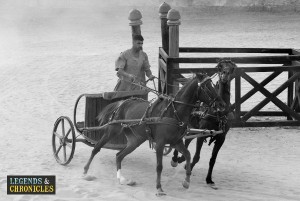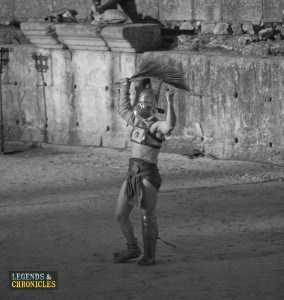Ancient Roman Sports
Ancient Romans played a variety of sports which included both indoor and outdoor sports. Rome also took various sports from Ancient Greece and changed their ritualistic nature into a display of physical strength and endurance. The wealthy Romans had large playing fields and structures known as gymnasia and palaestrae in their villas. The sports were often played at these places since it was considered a status symbol for the rich. Eventually the patronage of the empire for sports came about in the era of Emperor Nero when the first public gymnasium was built, followed by giant amphitheatres. With the passage of time, violent sports and large amphitheatres became one of the symbols of Roman power.
Emperor Nero ruled Rome from 37 AD to 68 AD and it was during his reign that large-scale state patronage of sports began. This resulted in the construction of large amphitheatres for various sports, in particular the violent fights of the gladiators. Before Nero, the rich people personally financed sports in the gymnasia constructed in their villas. The amphitheatres constructed by the government were large stadiums with racetracks. These amphitheatres also had chambers for wild animals and chapels where the players could pray. The amphitheatres were, therefore, the epitome of ancient Roman sports.
Chariot racing
One of the most popular among the ancient Roman sports was chariot racing. Chariot racing existed in Greece which was probably the inspiration for Roman chariot racing. It was one of the main events of ancient Olympics and other Pan-Hellenic Games. In ancient Rome, chariot racing took place between different teams and each team was financially backed by different groups. The intense interest of Romans in this game often resulted in clashes between the supporters of different teams and even caused political conflicts. Due to these problems, later Roman and Byzantine emperors appointed officials to ensure the peaceful nature of the game.
Gladiator fighting
Gladiator fights were among the bloodiest of all Roman sports. Gladiators were armed combatants who entertained the audience through their bloody fights with other gladiators. But the fights were not just restricted to humans and often gladiators had confrontations with wild animals. Most of the gladiators were slaves who were nourished under harsh conditions and remained segregated throughout their lives and even after their death. The bloody fights of the gladiators were loved by the Romans because they embodied the martial ethics of ancient Rome and they enjoyed popular acclaim. The exact origins of the game are hard to trace but it is thought to have started some time during the 3rd century BC.
Roman boxing
Boxing in ancient Rome, known as Pugilatus, was also one of the most popular sports. However, the rules were different from the modern day boxing since the players in this sport could strike any part of the body including the back and genitals. Like various other Roman sports, this was a wild display of physical strength and endurance.
There was no time limit under the boxing rules of the time and exhaustion or giving up of one of the fighters ended the game. The gloves worn by the players in this game were called Imantes Oxeis and had Greek origin. The gloves were made of leather with stiff rings of leather wrapped around the fingers in order to reduce the impact of the knuckles.
Hoop rolling
Not all sports in ancient Rome were bloody and violent and there were various quite peaceful sports that were mainly enjoyed by the children. One of the sports most popular with the children was hoop rolling that has remained more or less the same through the ages. This sport, like many other things, was taken by the Romans from the Greeks and the hoop was often referred to as ‘Greek Hoop’, although the dominant Latin term for the hoop was trochus. The stick, on the other hand, was known as clavis or radius and was usually made of metal with a wooden handle. According to the Greek historian Strabo, the most popular venue in Rome for this game was Campus Martius. Other than that, Sarmatian boys also rolled hoops on the frozen Danube River.
Roman ball game
Among other Roman sports, we can mention Harpastum which was a form of ball game. Romans also called it the small ball game since the ball used was quite small, almost equal to the size of a softball. As happened in many other sports in Rome, this game was also a Romanized version of the previously existing Greek game called phaininda. Hardly anything is known about the exact rules of this game but it did require a lot of agility and physical effort. Pictures of people playing this game have been found in ancient Roman frescos.
Indoor Roman games
Other than the outdoor sports, various indoor sports and games were also popular. One such game was Roman Chess which was known as Ludus latrunculorum. It was not exactly similar to modern day chess but resembled it to some extent and was considered a game of military tactics. Considering that the evidence is little, not much is known about the exact rules of this game.
There were several other board games prevalent in ancient Rome as well, for instance dice known as ‘tesserae’, knuckle bones known as tali or tropa, Roman Checkers known as Calculi, and various others.
Ancient Roman sports in summary
Ancient Roman society put a lot of emphasis on physical fitness and agility. The sports in ancient Rome were designed for considerable physical exertion, although there were various indoor sports as well. Among the most popular outdoor sports we can include the bloody fights of the gladiators, chariot racing which often ended in clashes between the supporters of opposite teams, and others. Before Emperor Nero, these sports were mainly played in the villas of rich people and it was Nero who constructed the grand amphitheatres and brought these games under the official patronage. With the passage of time, these sports became one of the symbols of Roman power.

